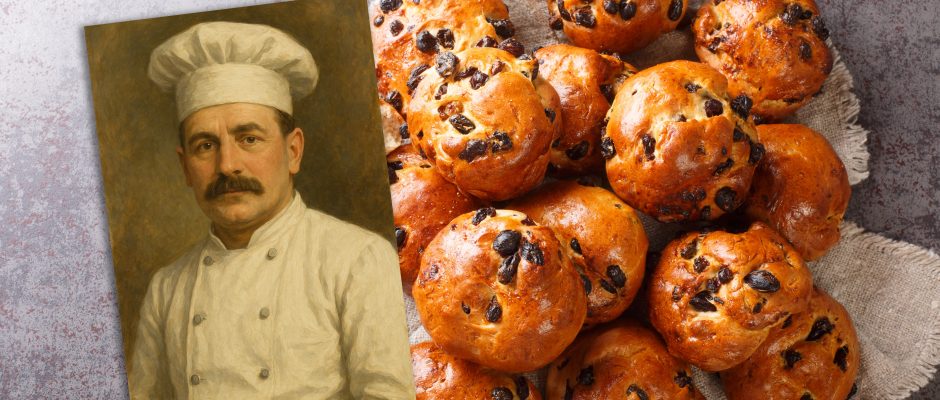In the early hours of April 15, 1912, as the RMS Titanic slipped beneath the icy waters of the North Atlantic, chaos engulfed the decks. Amid the panic, one man stood out—not for fleeing the disaster, but for facing it with courage, skill, and an extraordinary act of humanity. His name was Charles Joughlin, the ship’s Chief Baker.
For family and consumer science educators, the story of Joughlin is more than a tale of survival—it’s an inspiring entry point into history, character education, food science, and of course, baking.

The Baker Who Wouldn’t Sink
Born in England in 1878, Charles Joughlin began his career at sea at the age of 11. By the time he boarded Titanic, he was a seasoned baker overseeing a team responsible for producing thousands of rolls, breads, and pastries each day.
When disaster struck, Joughlin didn’t freeze. He helped load lifeboats, brought provisions to passengers, and ultimately gave up his own chance at a seat, choosing instead to hurl deck chairs into the sea as makeshift flotation devices. His cool head and leadership saved lives. He was the last person to leave the ship, riding the stern as it slipped under. Miraculously, he survived the freezing waters—thanks, some believe, to the alcohol he’d consumed earlier to steel his nerves and the internal warmth generated by his body’s physical exertion.
Joughlin’s story is a reminder to students that the kitchen builds more than technical skills. It fosters resilience, adaptability, leadership, and quick thinking—qualities that can shine even in the most extreme circumstances.
Titanic Currant Buns Recipe
Adapted from third-class menus served aboard the RMS Titanic

– 2 ½ cups all-purpose flour
-¼ cup granulated sugar
-1 tsp salt
-1 packet (2 ¼ tsp) active dry yeast
-¾ cup warm milk (about 110°F)
-1 egg
-¼ cup unsalted butter, melted
-½ cup dried currants
-Optional: 1 tsp cinnamon or mixed spice
-Optional glaze: 1 tbsp milk + 1 tbsp sugar
In a small bowl, dissolve yeast in warm milk and let sit until foamy
(5–10 minutes).
In a large bowl, mix flour, sugar, salt, and optional spices.
Add yeast mixture, egg, and melted butter. Stir until a soft dough forms.
Knead on a floured surface for 8–10 minutes, adding currants in the final minutes.
Place dough in a greased bowl, cover, and let rise until doubled (about 1 hour).
Divide dough into 12 even pieces, shape into rounds, and place on a parchment-lined baking sheet.
Cover and let rise again for 30–40 minutes.
Preheat oven to 375°F. Brush buns with optional glaze.
Bake for 15–18 minutes, or until golden brown. Cool on a wire rack. Serve warm with butter or jam.
Classroom Conversations: Connecting the Kitchen to History
Family and consumer science educators can use Charles Joughlin’s story and this recipe in dynamic, cross-curricular ways:
1. History Meets Hospitality:
Use Joughlin’s biography to launch a discussion about class distinctions aboard the Titanic—how third-class passengers were fed compared to those in first-class. Explore how menus reflect society and economic structures.
2. Science and Survival:
Delve into the science of yeast and fermentation, or the role of high-energy foods like currant buns in survival situations. Discuss how a baker’s knowledge of ingredients and food storage was crucial on long sea voyages.
3. Courage in the Kitchen:
Joughlin’s actions make for a compelling conversation about leadership, teamwork, and crisis response. Invite students to reflect on how the skills they build in class—planning, working under pressure, attention to detail—are life skills that extend far beyond the kitchen.
4. Global Bread Traditions:
Use the currant bun as a jumping-off point to explore sweet buns and breads from other cultures—Swedish kardemummabullar, Mexican pan dulce, or Jamaican spice buns—helping students understand how ingredients, climate, and culture shape recipes.
Kitchen Science: Getting to Know Yeast
Check out the following educational resources about yeast provided by HBA Member Red Star Yeast!
A Legacy That Rises
Charles Joughlin went on to live a long life, eventually retiring in New Jersey. But it’s his steadfastness in the face of unthinkable disaster that makes him a model worth sharing—not just for his incredible survival, but for his commitment to others in the final moments of the Titanic.
Next time you bake a batch of currant buns, take a moment to honor the baker who rose to the occasion—and remind your students that sometimes, the quiet strength of a baker can be a lifeline for many.
Let history rise in your kitchen.






Comments are closed.